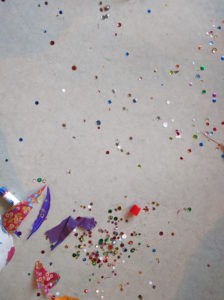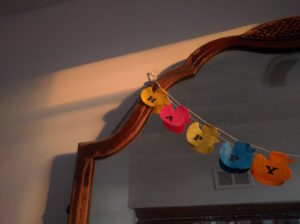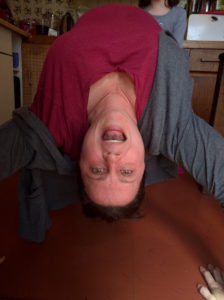April 18, 2016
In Praise of Messy Blogging
 I have started unfollowing all the people on Instagram whose corporeal selves are represented sole by a pair of legs. Not necessarily because it’s repetitive, because certainly they change up their knee socks and stripy tights, but because it’s just weird. How are we to know that these people are not (part of) an octopus? How much do you ever know a person when you know her only from the mid-thigh down? And what are these disembodied limbs (that are not entirely distinct from the kind you’d find at a crime scene, albeit a carefully arranged, colour-coded crime scene with impeccable lighting) telling us about the way that people are decided to construct their selves online?
I have started unfollowing all the people on Instagram whose corporeal selves are represented sole by a pair of legs. Not necessarily because it’s repetitive, because certainly they change up their knee socks and stripy tights, but because it’s just weird. How are we to know that these people are not (part of) an octopus? How much do you ever know a person when you know her only from the mid-thigh down? And what are these disembodied limbs (that are not entirely distinct from the kind you’d find at a crime scene, albeit a carefully arranged, colour-coded crime scene with impeccable lighting) telling us about the way that people are decided to construct their selves online?
I’ve been thinking about writing this blog post since reading Melanie’s Instagram post on social-media burnout a few weeks ago. She’d been contacted by someone wondering why she didn’t separate her bookish Instagram posts from ones related to her personal life, her family and her health, and become “a real bookstagrammer.” It’s advice I find so baffling as someone who’s been sharing my life online for nearly sixteen years, as well as reading about other people’s lives. Because for me, these windows into other people’s worlds has always been the most remarkable thing about web 2.0 and beyond it. In the very best book blogs, it’s not necessarily the reviews themselves that are so compelling, but what they tell us about the person who is writing them, and how the books fit into the larger narrative of the writer’s life. And I end up having a better understanding of where the writer is coming from and how their reviews work because I’ve read the posts in between (and between their lines even) and have a sense of who these people really are.
 Partly this is a question of medium, of course, of platform. Superficially, old school blogs and Instagram are different, though I would argue that the latter is definitely informed by the former. And because there is no character limit on captions, Instagram has the same potential for in-depth posts which is followed up by the kind of community engagement we haven’t really seen on blogs for about a decade. But there is not the same sense of ownership of an Instagram account that one has of a blog, a “homepage,” and more of a tendency toward conformity and memes. With the immediacy of Instagram, it’s simplest to learn how it’s done by watching others. The community connections resulting from hashtags and memes are as such that Instagrammers are less inclined to operate beyond the lines of wider experience. Blogging was about being on the margins; Instagram is about being central. And of course, the platform is image-driven, and so how things look will always take priority over how things really are.
Partly this is a question of medium, of course, of platform. Superficially, old school blogs and Instagram are different, though I would argue that the latter is definitely informed by the former. And because there is no character limit on captions, Instagram has the same potential for in-depth posts which is followed up by the kind of community engagement we haven’t really seen on blogs for about a decade. But there is not the same sense of ownership of an Instagram account that one has of a blog, a “homepage,” and more of a tendency toward conformity and memes. With the immediacy of Instagram, it’s simplest to learn how it’s done by watching others. The community connections resulting from hashtags and memes are as such that Instagrammers are less inclined to operate beyond the lines of wider experience. Blogging was about being on the margins; Instagram is about being central. And of course, the platform is image-driven, and so how things look will always take priority over how things really are.
For me, a blog has always been a little bit like a selfie. (I don’t mean this in a bad way. Selfies are wonderful. Nothing tells a story like the human face, though it’s true that a little less duckface would go a long way.) This was the case even back when I started blogging, when platforms didn’t support images and no one’s phone even had a camera. The appeal of the blog has always been its human face, even with blogs as divergent as those lists of links that were essentially internet filters or those that functioned as online diaries. Whatever the material and how it was presented, a blog gave the reader a sense of the human being that was behind it. (Now whether that human being was an accurate representation of its writer is another story; I also love May Friedman’s suggestion that a person being about to construct their own online identity is not particularly a bad thing.)
 Sometimes I get the sense that Instagram is about obscuring the humanness though. Pip Lincolne has written a terrific post about virtuous intentions and true character—that one is about becoming while the other is about simply being. She posits that true character is less easily displayed through visuals and more likely to be found on Twitter or long-form blogs, while Instagram is the ideal platform for these people striving to be their best selves. Which can be kind of crazy-making. Which can have the effect of reducing a person to a pair of limbs, because everything else is too complicated.
Sometimes I get the sense that Instagram is about obscuring the humanness though. Pip Lincolne has written a terrific post about virtuous intentions and true character—that one is about becoming while the other is about simply being. She posits that true character is less easily displayed through visuals and more likely to be found on Twitter or long-form blogs, while Instagram is the ideal platform for these people striving to be their best selves. Which can be kind of crazy-making. Which can have the effect of reducing a person to a pair of limbs, because everything else is too complicated.
(I love Instagram. Have I made that clear? It enriches my life exponentially, and has connected me with amazing people, and inspires me immensely. It highlights that beauty is everywhere, even in the most curious corners. I also find it fascinating that Instagram, like blogging, is impossible to generalize about. For every pair of legs, there is a girl tight pants doing complex yoga poses on the beach or posing in the bathroom mirror showing off her fantastic outfit. I love the radicalness of Instagram accounts that give fat women or non-binary people the chance to construct their identities and be seen. And if the human face is what I’m looking for, there are many Instagram accounts that feature nothing but…though these accounts come with their own questions and complications.)
 Blogging is about process. This is what I tell my students, and for many of them their biggest challenges involve overcoming notions of perfectionism and letting their unpolished selves show, using a blog post as a kind of working-though (which is what I am doing right now). But Instagram, and more visual-driven blogs, are about results. It’s about polished veneers and flawless skin tones. There’s less room for nuance, for delving into the realities of being, warts and all. Instead, there’s just a photo of a wart. And who would ever want to look at that? And now it seems I’m getting confusing because if blogging is about process, then isn’t that the “becoming” that I connected with Instagram two paragraphs back? What’s the difference between becoming and process? But I think the distinction is that with blogging, process itself is a way of being. It’s accepting life itself as a work-in-progress, and the destination is never ever the point. (Arriving at your destination, of course, would only mean that you’ve finished blogging; it would only mean that you’re dead.)
Blogging is about process. This is what I tell my students, and for many of them their biggest challenges involve overcoming notions of perfectionism and letting their unpolished selves show, using a blog post as a kind of working-though (which is what I am doing right now). But Instagram, and more visual-driven blogs, are about results. It’s about polished veneers and flawless skin tones. There’s less room for nuance, for delving into the realities of being, warts and all. Instead, there’s just a photo of a wart. And who would ever want to look at that? And now it seems I’m getting confusing because if blogging is about process, then isn’t that the “becoming” that I connected with Instagram two paragraphs back? What’s the difference between becoming and process? But I think the distinction is that with blogging, process itself is a way of being. It’s accepting life itself as a work-in-progress, and the destination is never ever the point. (Arriving at your destination, of course, would only mean that you’ve finished blogging; it would only mean that you’re dead.)
In blogging, process means showing your work and necessitates a bit of a mess. You’ve got to be a bit vulnerable, which goes against all the general advice these days about building a brand online. But the reasons for not positioning oneself as an online guru are tenfold, least among them that you’re totally lying (and if you weren’t, you’d probably have a platform that wasn’t a blog), although ultimately it’s just not sustainable. As I explain in my blogging course, if you’re writing only about those things on which you’re an expert, you’re probably limiting yourself, whereas if you’re willing to explore all you don’t know, the possibilities are infinite. It also means that if you’re making your online project an act of discovery, you’re getting something out of it beyond the (likely) pennies of ad revenue coming your way. Anyone who has ever read a novel too knows that discovery is so much more interesting to read about than somebody who knows everything already.
I also think that the pressure to know everything and be everything all the time is a lot to put on a human being, one who is doing unpaid work at that. And that allowing that human to be human is healthy and therapeutic. When a person is feeling lost and alone, there is nothing more heartening than learning there is somebody else out there who’s been there, who understands…the amazing miracle of human connection that has always been the best part of blogs anyway.
 Letting humans be human then means that a person is not simply a pair of legs, or only a bookstagrammer. But rather that a person is a bookstragrammer with an actual life of which bookstagramming is simply a facet, and there are also friends and family, an interest in wildflowers and bundt cake, messy bedside bookstacks, children with dirty faces, an obsession with The Bachelor and Little House on the Prairie fan fiction—do you know what I am saying? Also, when you’re scrolling through photo after photo of impeccably arranged books on tea trays with sprigs from the garden and an artful jug against a painted wooden floor, don’t your eyes kind of glaze over?
Letting humans be human then means that a person is not simply a pair of legs, or only a bookstagrammer. But rather that a person is a bookstragrammer with an actual life of which bookstagramming is simply a facet, and there are also friends and family, an interest in wildflowers and bundt cake, messy bedside bookstacks, children with dirty faces, an obsession with The Bachelor and Little House on the Prairie fan fiction—do you know what I am saying? Also, when you’re scrolling through photo after photo of impeccably arranged books on tea trays with sprigs from the garden and an artful jug against a painted wooden floor, don’t your eyes kind of glaze over?
Hybridization is the best thing that blogs have on their side—in terms of form and technology. And I am convinced the same can be true of content, no matter who’s out there persuading others to becoming “real bookstagrammers”. And who, by the way, are the people doing that kind of persuading? I do suspect their marketers looking for the peddling of their own wares, and it’s far more simpler and salubrious to have your products marketed (without pay, no less) by people who have no human foibles and are wart-free. It also makes me sad that there are people living who’ve never known a time in which the central experiences of being online were not selling stuff and being sold stuff. In the words of Bonnie Stewart, “forget agency and voices and relationships. if you are using your network solely to sell the message of a corporate entity, what you are doing is NOT social media, no matter your platform. what you’re doing is at best a marketing job, and more likely something akin to Amway.”
I am hopeful though. I’ve been noticing a trend among Instagrammers to show their faces once in a while, with various hashtags attached to this, latching onto some kind of meme, and positing the whole thing like some kind of revelation. With these big reveals too have come some genuinely fascinating insights: one woman explained that she’s been dealing with a debilitating skin ailment for the past while and she’s been terrified to show what she really looks like. Another reviewed the new book, 13 Ways of Looking at a Fat Girl, and wrote about being fat, something she’d never dealt with in her blog before and which never been clear in her carefully positioned photos. And I can’t help but think how liberating it must have felt to finally admit these things, to own one’s imperfections, to put these things out there for everyone to see and discover that the world still likes you anyway. And for readers I am sure these posts were most remarkable too; certainly here I am still thinking about them weeks later.






AHG! I’m so looking forward to spending the weekend reading all these links… i cannot wait until the weekend! a very rich post…
I’ve already said this on Instagram, but I feel like this is your internet home & so I should say it again here: I love, love, love this post. So much to think about & so much to agree with. Thanks for thinking aloud & reminding me why I love you & your blog so very much.
I have no Instagram experience, but I so agree with what you say about the “human face” and hybridity of blogging. I have sometimes thought that my own blog would be somehow more “successful” if it were more narrowly one thing or another (all books, all academics, all personal) — but my life is all three of those things and more, and my blog sometimes feels like the one place where that’s OK! What’s the point of *any* of these ways of (virtual) being in the world, except to be the selves we want to be there, after all, messy as we really are? Thanks, as always, for giving me lots to think about!
I’m finally getting around to commenting on this post. And yes, I love love love it too. Every single thing about it. This post and your kind e-mails have meant that I have spent the day re-building my old blog (did you know you can import/export posts from other blogs?) and drinking too much tea and eating vanilla Oreos even though I’m not supposed to have sugar. I have the shakes now but my blog looks good so it all evens out. 😉
The notion of lives as “brands” creates an awful flatness to something that is naturally multifaceted and messy. Thanks for sharing these thoughts – a refreshingly honest read!